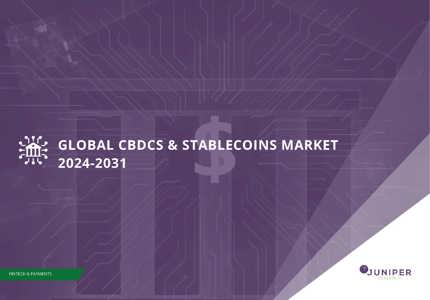What Are CBDCs & Stablecoins?
Payments are in a constant state of development, but the current market has seen the possibilities for payment types accelerate beyond what many in the market expected. To date, blockchain has had a mixed impact across payments and banking, but the rise of stablecoins and CBDCs threatens to accelerate this impact significantly.
As we discuss in our latest research , stablecoins and CBDCs are two ways of solving the same problem – how do you offer a better digitally native payments solution? Most existing payment types have been designed around traditional systems intended for in-person or telephone payments, such as credit cards, or even cash. Stablecoins and CBDCs are showing what can happen if a system is designed from the ground up as digital.
However, this begs the question: precisely what are CBDCs and stablecoins?
CBDCs
A CBDC is an additional form of money issued, monitored and controlled by a central bank. Similar to fiat currencies, the supply of CBDCs is also controlled by a central bank’s monetary and fiscal policies.
What makes CBDCs different to stablecoins and other forms of decentralised digital currencies is that, when issued by the central bank, it must be accepted as a form of payment by all within the market. Additionally, it must be a safe store of value by all consumers, merchants, stakeholders and government agencies.
However, similar to a stablecoin, a CBDC is pegged 1:1 to the corresponding fiat currency, meaning that the value of the crypto coin is always the same as the fiat currency. Additionally, as it is a digital currency, consumers are required to have a digital wallet, but do not need to have a traditional bank account to use and hold CBDCs.
CBDCs are fundamentally different to other forms of cryptocurrency. The intention is that a CBDC would largely rely on the existing payment infrastructure and would need to be integrated with core banking systems to enable payments without the need to create and install an entirely new financial infrastructure. Therefore, as an objective, the deployment of a CBDC is completely different to a stablecoin. A CBDC is designed to enhance and complement existing payment systems, whereas a stablecoin is designed to bypass them completely.
The corresponding digital wallets used for CBDCs can be used with smartphones, smart devices and wearables, in the same way as a typical digital wallet service that may or may not be linked to a card or bank account.
Stablecoins
A stablecoin is a cryptocurrency that has its value pegged to that of another currency, commodity or alternative financial instrument.
Stablecoins can be exchanged or integrated with other digital assets, as they are a store of value and medium of exchange through DLTs (Distributed Ledger Technology). Transactions using stablecoins do not rely on an intermediary to facilitate a settlement, which means that transactions can be settled almost instantly.
Additionally, this means that payments and transactions can be made 24/7, with no restrictions or wait times, as they do not rely on a payment facilitator. The reason stablecoins were developed was to combine the benefits of cryptocurrencies, including being encrypted and cryptographically secured, without the volatility associated with decentralised cryptocurrencies.
There are four main types of stablecoins, which are detailed below:
Fiat-collateralised stablecoins: A fiat-backed stablecoin is a cryptocurrency that is pegged to the value of a fiat currency to ensure it follows the price dynamics of its associated currency. Additionally, the stablecoin is backed by physical cash held in reserves.
Crypto-collateralised stablecoins: This is a completely decentralised way of creating a relatively more stable crypto coin, by backing the value of the stablecoin with digital asset reserves, instead of fiat cash reserves. It is key to note that this method of backing cryptocurrencies still leads to high levels of fluctuations and price volatility, but by over-collateralising the coins, the risk of the coin completely crashing is reduced.
Commodity-collateralised stablecoins: These are cryptocurrencies backed by a reserve of real assets such as oil or gold. Commonly, this works by pegging the value of one coin to a specific unit of a commodity. For example, a stablecoin may be backed to one fine ounce of gold held in a reserve.
Algorithmic stablecoins: These are coins that are not backed by any kind of asset, nor do they use any reserve. Instead, the stablecoin uses a completely algorithmic approach, which adjusts the supply of the coin in response to fluctuations in price, creating a price stability mechanism. An example of this would include incentivising users to sell a particular coin that is trading above a certain value, at a profit, to pull the price back down to a more stable rate.
As stablecoins can function as independent blocks, they can operate with smart contracts to create payments and other financial services. Within this model, stablecoins can be transacted when certain conditions written into the code have been met, providing a fully automated solution.
However, stablecoins do have some limitations. Like traditional cryptocurrencies, stablecoins are not centrally controlled, they are distributed. This can raise a challenge for central banks and payment system regulators, who will seek greater control over the payment rails that are available within their areas of responsibility.
Related Reading
Our complimentary whitepaper, CBDCs ~ A New Wave in Payments, examines the progress to date within CBDC development and the potential for future growth.
“Juniper Research’s new CBDCs & Stablecoins research provides in-depth analysis and evaluation of how these new payment system risk types are being developed and commercialised within financial markets; delivering critical insights on how they will change business models in payments, key vendors driving the evolution of the market and the future prospects for these payment types of digital assets. It provides an evaluation of the development of CBDCs (Central Bank Digital Currencies) and stablecoins across 19 different key countries of interest. The study also contains the Juniper Research Competitor Leaderboard; positioning 15 key CBDCs platform vendors.”
Latest research, whitepapers & press releases
-
 ReportDecember 2025
ReportDecember 2025AI Agents for Customer Experience Platforms Market: 2025-2030
Our comprehensive AI Agents for Customer Experience Platforms research suite comprises detailed assessment of a market that is set to disrupt mobile communications. It provides stakeholders with insight into the key opportunities within the AI agents for customer experience platforms market over the next two years.
VIEW -
 ReportDecember 2025Fintech & Payments
ReportDecember 2025Fintech & PaymentseCommerce Fraud Prevention Market: 2025-2030
Our eCommerce Fraud Prevention research suite provides a detailed and insightful analysis of this evolving market; enabling stakeholders from financial institutions, law enforcement agencies, regulatory bodies and technology vendors to understand future growth, key trends, and the competitive environment.
VIEW -
 ReportNovember 2025Telecoms & Connectivity
ReportNovember 2025Telecoms & ConnectivityeSIMs & iSIMs Market: 2025-2030
Juniper Research’s eSIMs and iSIMs research suite offers insightful analysis of a market set to experience significant growth in the next five years. The research suite provides mobile network operators (MNOs), original equipment manufacturers (OEMs), and eSIM management and platforms vendors with intelligence on how to capitalise on the market growth, and guidance on how eSIM-only devices and sensors, SGP.42, in-factory provisioning, and iSIMs will change the competitive landscape.
VIEW -
 ReportNovember 2025Fintech & Payments
ReportNovember 2025Fintech & PaymentsModern Card Issuing Platforms Market: 2025-2030
Our Modern Card Issuing Platforms Market research suite provides a detailed and insightful analysis of this evolving market; enabling stakeholders from banks, financial institutions, fintech companies, and technology vendors to understand future growth, key trends, and the competitive environment.
VIEW -
 ReportNovember 2025Fintech & Payments
ReportNovember 2025Fintech & PaymentsDigital Wallets Market: 2025-2030
Our digital wallets research suite provides detailed analysis of this rapidly changing market; allowing digital wallet providers to gain an understanding of key payment trends and challenges, potential growth opportunities, and the competitive environment.
VIEW -
 ReportOctober 2025Fintech & Payments
ReportOctober 2025Fintech & PaymentsDigital Identity Market: 2025-2030
Juniper Research’s Digital Identity research suite provides a comprehensive and insightful analysis of this market; enabling stakeholders, including digital identity platform providers, digital identity verification providers, government agencies, banks, and many others, to understand future growth, key trends, and the competitive environment.
VIEW
-
 WhitepaperDecember 2025Telecoms & Connectivity
WhitepaperDecember 2025Telecoms & ConnectivityHuman + AI: Drivers of Customer Experience AI Agents in 2026
Our complimentary whitepaper, Human + AI: Drivers of Customer Experience AI Agents in 2026, examines the key drivers of the AI agents for customer experience platforms market in 2025.
VIEW -
 WhitepaperDecember 2025Fintech & Payments
WhitepaperDecember 2025Fintech & PaymentsBeyond Chargebacks: The True Cost of Fraud for Digital Commerce
Our complimentary whitepaper, Beyond Chargebacks: The True Cost of Fraud for Digital Commerce, examines the state of the eCommerce fraud prevention market; considering the impact of evolving digital fraud strategies, including key trends such as identity theft, account takeovers, chargebacks, policy abuse and friendly fraud.
VIEW -
 WhitepaperNovember 2025Telecoms & Connectivity
WhitepaperNovember 2025Telecoms & ConnectivityeSIM-only Devices: The Impact on Operators, Consumers, and IoT
Our complimentary whitepaper, eSIM-only Devices: The Impact on Operators, Consumers, and IoT, explores the challenges and opportunities for the three segments, with a particular focus on eSIM-only smartphones and SGP.42.
VIEW -
 WhitepaperNovember 2025Fintech & Payments
WhitepaperNovember 2025Fintech & PaymentsUnlocking the Next Stage of Growth for Modern Card Issuing Platforms
This free whitepaper analyses key trends shaping the modern card issuing space, and the ways in which modern card issuing platforms can capture growth.
VIEW -
 WhitepaperNovember 2025Fintech & Payments
WhitepaperNovember 2025Fintech & PaymentsTop 10 Fintech & Payments Trends 2026
Fintech is evolving fast. From stablecoins to agentic AI, our annual guide reveals the shifts redefining payments, digital identity, and the future of money in 2026. Download your copy today.
VIEW -
 WhitepaperNovember 2025Fintech & Payments
WhitepaperNovember 2025Fintech & PaymentsDigital Wallets: Empowering Financial Inclusivity
Our complimentary whitepaper, Digital Wallets: Empowering Financial Inclusivity, examines the state of the digital wallets market; considering the impact of digital wallets on different geographies, how they are shaping the modern payments landscape through lower transaction fees and promoting financial inclusivity for underbanked populations, and how they are competing with established payment methods.
VIEW
-
IoT & Emerging Technology
Juniper Research Unveils Top 10 Emerging Tech Trends to Watch in 2026
January 2026 -
Fintech & Payments
Digital Identity App Usage to Hit 6.2 Billion by 2030, Driven by Shift to Decentralised Models
December 2025 -
Telecoms & Connectivity
Travel eSIM Margins Under Pressure as Revenue per Gigabyte Falls 10% Globally in Two Years
December 2025 -
Telecoms & Connectivity
AI Agents to Power 1,000% More Customer Interactions for Enterprises Globally by 2027
December 2025 -
IoT & Emerging Technology
Global D2C Revenue Set for $370 Million Surge, But Satellite Operators Should Not Chase Full MNO Status
December 2025 -
Fintech & Payments
Digital Goods Fraud to Cost eCommerce Merchants $27 Billion Globally by 2030 as AI Tools Accelerate Attacks
December 2025





















